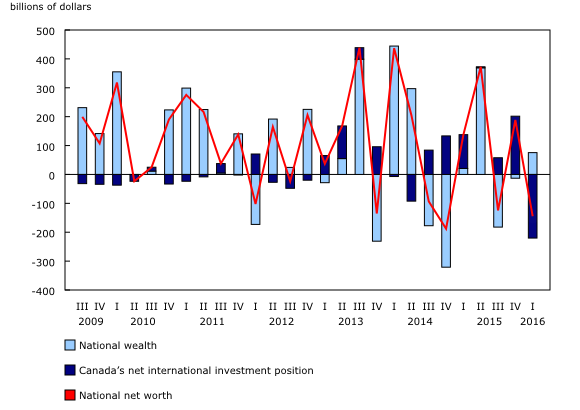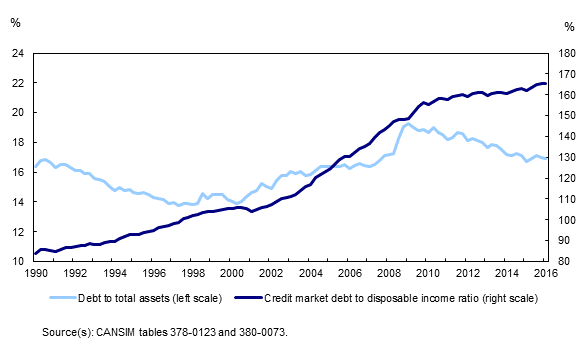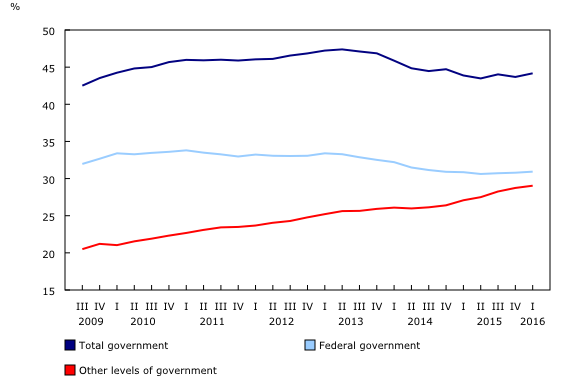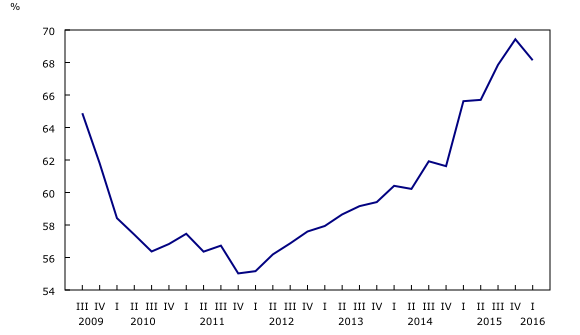National balance sheet and financial flow accounts, first quarter 2016
Archived Content
Information identified as archived is provided for reference, research or recordkeeping purposes. It is not subject to the Government of Canada Web Standards and has not been altered or updated since it was archived. Please "contact us" to request a format other than those available.
Released: 2016-06-14
National net worth declines as Canada's net foreign asset position weakens
National net worth declined 1.5%, or $144.7 billion, to $9,571 billion at the end of the first quarter. This was mainly due to a decrease in the market value of financial assets held abroad, as Canada's net foreign asset position fell in the first quarter. On a per capita basis, national net worth was $265,200 compared with $269,500 in the fourth quarter.
National wealth, the total value of non-financial assets in the Canadian economy, rose $75.6 billion to $9,306 billion at the end of the first quarter. The main contributor to growth was a $105.2 billion increase in the value of real estate. This was partially offset by a $36.0 billion decline in the value of natural resource wealth, as energy prices continued to decrease.
Canada's net foreign asset position fell $220.2 billion in the first quarter to $264.8 billion. This decline more than offset the $201.7 billion gain recorded in the fourth quarter. Canada's international assets were down in the first quarter, while international liabilities edged up. The appreciation of the Canadian dollar, combined with the stronger performance of the Canadian stock market relative to foreign stock markets, mainly contributed to the drop in the net foreign asset position.
Household net worth increases, driven by real estate
Household sector net worth at market value rose 1.2% in the first quarter to $9,633 billion. On a per capita basis, household net worth was $266,900. Financial assets increased 0.7%, the weakest first quarter growth since 2009. Driven by gains in the value of real estate, the growth of non-financial assets (+1.5%) outpaced that of financial assets. As a result, the ratio of financial assets to non-financial assets decreased to 111.4%. Overall, the value of household assets rose $122.3 billion, while liabilities grew $9.0 billion; the ratio of household debt to total assets edged down to 16.9%.
Total household credit market debt (consumer credit, and mortgage and non-mortgage loans) reached $1,933 billion at the end of the first quarter. Consumer credit was $573.1 billion, while mortgage debt stood at $1,268 billion. The share of mortgage liabilities to total credit market debt reached 65.6% at quarter end, continuing an unbroken upward trend that began in the first quarter of 2010.
The ratio of household credit market debt to disposable income (excluding pension entitlements) was little changed in the first quarter, edging down to 165.3%. In other words, households held $1.65 in credit market debt for every dollar of disposable income. Disposable income and household credit market debt increased at nearly the same rate.
The household debt service ratio, measured as total obligated payments of principal and interest as a proportion of disposable income adjusted to include actual interest paid, increased to 14.8% in the first quarter. The interest-only debt service ratio, defined as household mortgage and non-mortgage interest paid as a proportion of disposable income, was 6.6% in the first quarter.
On a seasonally adjusted basis, households borrowed $24.4 billion in the first quarter, up $0.5 billion from the previous quarter. Mortgage borrowing represented $17.5 billion of total borrowing in the quarter, down from $20.7 billion in the previous quarter, while borrowing in the form of consumer credit and non-mortgage loans was $6.9 billion, up from $3.2 billion.
Federal government net debt to gross domestic product edges up
The ratio of federal government net debt (book value) to gross domestic product edged up to 30.9% in the first quarter from 30.8% in the fourth quarter. The ratio for other levels of government was up slightly from the previous quarter to 29.0%, continuing an upward trend that began in late 2008.
The federal government recorded $9.1 billion in net retirements of Canadian short-term paper in financial markets in the quarter, which was offset by $9.6 billion in net issuances of bonds and debentures.
Other levels of government borrowed $7.9 billion on financial markets during the quarter. The bulk of borrowing was $13.3 billion in net issuances of Canadian bonds and debentures, but this was partly offset by $5.6 billion in net retirements of Canadian short-term paper.
Non-financial private corporations' borrowing slows from fourth quarter
Non-financial private corporations borrowed $3.9 billion worth of funds in financial markets in the first quarter, down sharply from $26.2 billion in the previous quarter and representing the lowest value since the fourth quarter of 2011.
On a book value basis, the credit market debt to equity ratio of non-financial private corporations was down in the first quarter, following four consecutive quarterly increases. There was 68 cents of credit market debt for every dollar of equity at quarter end.
Foreign equities reduce the value of financial corporations' assets
Overall, the financial sector provided $21.7 billion of funds to the economy through credit market instruments, down from $48.2 billion in the previous quarter. The funds provided in the first quarter were mainly in the form of non-mortgage loans ($15.7 billion), bonds and debentures ($14.8 billion), and mortgages ($11.5 billion). Financial corporations recorded net redemptions of Canadian short-term paper ($15.2 billion).
The value of financial assets of financial corporations decreased $45.8 billion at the end of the first quarter to $12,133 billion. The principal contributor to this decrease was a $73.3 billion decline in the value of foreign equities, as the Canadian dollar had appreciated by the end of the first quarter.
Note to readers
This release of the financial and wealth accounts comprises the national balance sheet accounts (NBSA), financial flow accounts (FFA) and other changes in assets accounts (OCAA).
The NBSA are composed of the balance sheets of all sectors and subsectors of the economy. The main sectors are households, non-profit institutions serving households, financial corporations, non-financial corporations, government and non-residents. They cover all national non-financial assets and financial asset-liability claims outstanding in all sectors. To improve the interpretability of the estimates of the financial flows, selected household borrowing series are available on a seasonally adjusted basis (CANSIM table 378-0127). All other data are unadjusted for seasonal variation. For information on seasonal adjustment, see Seasonally adjusted data – Frequently asked questions.
The FFA articulate net lending or borrowing activity by sector by measuring financial transactions in the economy. The FFA arrive at a measure of net financial investment, which is the difference between transactions in financial assets and liabilities (for example, net purchases of securities less net issuance of securities). The FFA also provide the link between financial and non-financial activity in the economy, which ties estimates of saving and non-financial capital acquisition (for example, investment in new housing) with the underlying financial transactions.
While the FFA record changes in financial assets and liabilities between opening and closing balance sheets that are associated with transactions during the accounting period, the value of assets and liabilities held by an institutional unit can also change for other reasons. These other types of changes, referred to as other economic flows, are recorded in the OCAA.
There are two main components to the OCAA. One is the other changes in the volume of assets account. This account includes changes in non-financial and financial assets and liabilities relating to the economic appearance and disappearance of assets, the effects of external events such as wars or catastrophes on the value of assets, and changes in the classification and structure of assets. The other main component is the revaluation account, showing holding gains or losses accruing to the owners of non-financial and financial assets and liabilities during the accounting period as a result of changes in market price valuations.
At present, only the aggregate "other change in assets" is available within the Canadian System of Macroeconomic Accounts; no details are available on the different components.
Definitions concerning financial indicators can be found in "Financial indicators from the National Balance Sheet Accounts" and in the System of Macroeconomic Accounts glossary.
Revisions
Data on financial and wealth accounts for the first quarter were released along with revised data for the first, second, third and fourth quarters of 2015. These data incorporate new and revised data, as well as updated data on seasonal trends.
Additional information on the treatment of natural resource wealth in the NBSA is available in the article, "Natural resource wealth statistics in the National Balance Sheet Accounts."
Next release
Data on the NBSA and FFA for the second quarter will be released on September 15.
Products
The System of Macroeconomic Accounts module, accessible from the Browse by key resource module of our website, features an up-to-date portrait of national and provincial economies and their structure.
The Methodological Guide: Canadian System of Macroeconomic Accounts (13-607-X) is now available from the Browse by key resource module of our website, under Publications.
The User Guide: Canadian System of Macroeconomic Accounts (13-606-G) is now available from the Browse by key resource module of our website, under Publications. This publication will be updated to maintain its relevance.
Contact information
For more information, or to enquire about the concepts, methods or data quality of this release, contact us (toll-free 1-800-263-1136; 514-283-8300; STATCAN.infostats-infostats.STATCAN@canada.ca) or Media Relations (613-951-4636; STATCAN.mediahotline-ligneinfomedias.STATCAN@canada.ca).
- Date modified:







